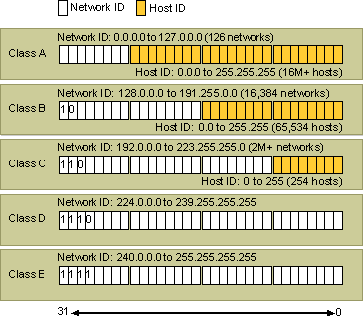 Important: Important: |
|---|
| This is retired content. This content is outdated and is no longer being maintained. It is provided as a courtesy for individuals who are still using these technologies. This content may contain URLs that were valid when originally published, but now link to sites or pages that no longer exist. |
The Internet community has defined IP address classes: A, B, C, D, and E. To accommodate varying network sizes, each address class handles network addressing for a network of a unique size. The class defines the possible number of networks and the number of hosts for each network. Each class also defines which bits of the IP address are used for the network identifier and which bits are used for the host identifier. The following illustration shows the IP address settings for the five IP address classes.

The following table shows address classes supported by Windows Embedded CE.
| Address class | Description |
|---|---|
|
Class A |
Assigned to networks with a large number of hosts. The high-order bit in a class A address is always set to 0. The next seven bits, completing the first octet, complete the network identifier. The remaining 24 bits — the last three octets — represent the host identifier. This accommodates 126 networks, 128 minus two reserved addresses, and over 16 million hosts for each network. |
|
Class B |
Assigned to networks with a medium to large number of hosts. The two high-order bits in a class B address are always set to 10. The next 14 bits — completing the first two octets — complete the network identifier. The remaining 16 bits — the last two octets — represent the host identifier. This accommodates 16,384 networks and more than 65,000 hosts for each network. |
|
Class C |
Assigned to networks with a small number of hosts, specifically, local area networks (LANs). The three high-order bits in a class C address are always set to 110. The next 21 bits — completing the first three octets — complete the network identifier. The remaining 8 bits — the last octet — represent the host identifier. This accommodates more than 2 million networks and 254 hosts for each network. |
|
Class D |
Used for multicasting to a number of hosts. Packets are passed to a selected subset of hosts on a network. Only those hosts registered for the multicast address accept the packet. The four high-order bits in a class D address are always set to 1110. The remaining bits are for the address that registered hosts will recognize. Windows Embedded CE supports class D addresses for applications to multicast data to hosts. |
|
Class E |
Reserved for future use. An experimental address. High-order bits in a class E address are set to 1111. |








 See Also
See Also